Evaluation of water quality of goundwater recharge in Wadi Feifa, Southern Jordan Valley, Jordan
Rakad Ta’any1 * , Anwar Jiries2 , Ali EL-Naqa3 , Mohammad Al Momani4 and Muwaia Samara4
1
Faculty of Agricultural Technology,
Al Balqa Applied University,
As Salt,
19117
Jordan
2
Faculty of Science,
Mutah University,
Mutah,
61710
Jordan
3
Faculty of Natural Resources and Environment,
Hashemite University,
Zerqa,
Jordan
4
Ministry of Water and Irrigation,
P.O. Box 2412,
5012 Amman,
Jordan
DOI: http://dx.doi.org/10.12944/CWE.3.2.02
A pilot study was carried out during winter 2007-2008 at Ghor Feifa Jordan Valley weir to estimate the quantity and quality of artificially recharged water originating from wadi Feifa surface runoff. Results showed that there was a good relationship between the quantity and quality of the stream feeding the diversion weir and groundwater quality. The amounts of water recharging local aquifers were estimated to be 0.15m³/m/h. The major ionic concentration of the water in the investigated site at different periods indicated that there is an increase in TDS during the first two months of the investigated period due to no rain during November and December 2007; thereafter, during January and February 2008 a decrease in all ionic concentrations in both surface and groundwater was observed. Stable isotopic composition of water collected from surface and groundwater indicated the same origin of water which is rain water without strong evaporation effect. The tritium concentration of both surface and groundwater were less than 1 indicating that the most probable source of water in the investigation area is from old groundwater in form of base flow in addition to treated wastewate
Copy the following to cite this article:
Taany R, Jiries A, El-Naqa A, Al Momani M, Samara M. Evaluation of water quality of goundwater recharge in Wadi Feifa, Southern Jordan valley, Jordan. Curr World Environ 2008;3(2):217-222 DOI:http://dx.doi.org/10.12944/CWE.3.2.02
Copy the following to cite this URL:
Taany R, Jiries A, El-Naqa A, Al Momani M, Samara M. Evaluation of water quality of goundwater recharge in Wadi Feifa, Southern Jordan valley, Jordan. Curr World Environ 2008;3(2):217-222. Available from: http://www.cwejournal.org/?p=821
Download article (pdf)
Citation Manager
Publish History
Select type of program for download
| Endnote EndNote format (Mac & Win) | |
| Reference Manager Ris format (Win only) | |
| Procite Ris format (Win only) | |
| Medlars Format | |
| RefWorks Format RefWorks format (Mac & Win) | |
| BibTex Format BibTex format (Mac & Win) |
Article Publishing History
| Received: | 2008-10-10 |
|---|---|
| Accepted: | 2008-11-24 |
Introduction
Limited water resources in Jordan is a national problem due to limited recharge, population growth and increasing demand from industry and agricultural sectors. These constraints led to deterioration of water quality and declining of water level. Therefore conservation of the existing water resources is essential.
To face the high water demand, groundwater resources had been exploited at rates much higher than those of the recharge where the difference between demand and supply exceeds 175 MCM annually (Haddadin, 2008). In 1994, Jordan launched a program to explore the use of groundwater artificial recharge with the aim to offset some of the problems caused by this overexploitation.
In arid and semi-arid areas, assessment of groundwater recharge is one of the key challenges in determining the sustainable yield of aquifers as recharge rates are generally low. In the current study, the groundwater recharge was estimated as defined by Lloyd (1986) on the basis of average annual rainfall: hyper-arid: 0-50 mm/yr; arid: 50-200 mm/yr and semi-arid: 200-500 mm/yr.
Many studies were carried out on recharge calculations in Jordan. Recharge to the Rijam (B4) aquifer takes place in the mountainous highlands of Shoubak lying to the west of the Jafr Basin. Direct recharge by precipitation is negligible, because the surface area of the playa, where floodwater collects, is covered by very fine sediments, which do not allow for the rapid infiltration of recharge water. The total recharge to the B4 aquifer is around 7 MCM/year (Parker 1979). In the National Water Master Plan of Jordan (NWMP, 1977), the renewable groundwater amount, which does not appear as base flow is calculated to be 23 MCM/year. The recharge to the aquifer takes place in the highlands of Irbid and Ajlun and further to the northeast beyond Jordan’s territories. The deeper lying aquifers of A4 and Kurnub release some water to the B2/A7 in an upward movement, through the overlying aquiclude because their piezometric heads are higher than those of the B2/A7 (El-Nasser 1991).El-Nasser (1991) calculated a recharge to this aquifer of 127 MCM/year, with base and spring flows of 100 MCM/ year. In this figure the groundwater resources extending to Wadi Yabis, Wadi Jurum, Wadi El-Arab and the Yarmouk River are included. There are 18 desert dams storing about 31 MCM for the purpose of animal watering and artificial groundwater recharge. In addition, there are a number of water harvesting projects that utilize the surface water in forms of large ponds and small earth reservoirs (Ministry of Environment, 2006).
The main objectives of the current study are to examine the recharge efficiency of the Feifa Diversion Weir for proper management and development of the aquifer systems, investigate the impact of artificial recharge on groundwater quality and to determine of the quantity of groundwater recharge in the investigated area.
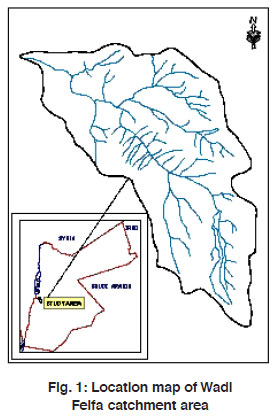 |
Figure 1: Location map of Wadi Feifa catchment area Click here to view figure |
Study Area
Wadi Feifa basin is located in southwest of Jordan and extends between Palestine Grid coordinates 35.28.13 -35.32.01E, and 30.56.01 - 30.55.27N covering an area of about 160 km2 (Fig. 1). The basin is bounded by Wadi Umruq from the west, Wadi Khuneizira from the southwest, Wadi Shihab from east and Wadi Cenozoic sedimentary rock underlie geological formation of Wadi Feifa. The age of the rocks is from the Camper- Ordovician to the upper Cretaceous. The structure settling of the Wadi is dominated by the Wadi Al-Hasa Fault.
Water resources in Wadi Feifa catchment area are; surface runoff, groundwater resources and treated wastewater. Surface water discharge from four main tributaries; Wadi Ruweim, Wadi Aima, Wadi Tafileh and Wadi Salim. All these wadies and other minor wadis meet to form Wadi Feifa with annual surface water discharge of about 4.56 MCM. Groundwater resources in the study area consist mainly of springs discharge. Wadi Feifa contains 22 springs emerging from different aquifers in the area, there average discharge range from 0.3m3/hr for Zibleh spring to 8.5 m3/hr for Un-Qarayah spring. Treated wastewater originated from Tafileh Treatment Plant, flows directly to Wadi Feifa at annual discharge of about 0.33 MCM.
Groundwater resources in the study area are presented by the pumped wells and the springs encountered in the catchment area, while surface water includes spring flow and flood flow.
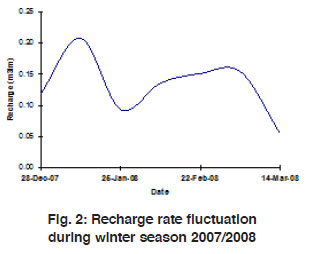 |
Figure 2: Recharge rate fluctuation during winter season 2007/2008 Click here to view figure |
Methodology
Field Works
Field visits to the investigation area were carried out during winter 2007-2008 to fulfill the aim of this current study. Wadi Feifa Diversion weir, which is the focal point of this investigation and groundwater downstream were sampled at different periods for chemical analysis to find the impact of surface runoff during winter period on its water quality. The discharge of the base flow of Wadi Feifa was measured using current meter and portable weir (16 cm size). the historical data were also compiled from the Ministry of Water and Irrigation (MWI) open files. The discharges of the springs located in the catchment area were measured as well.
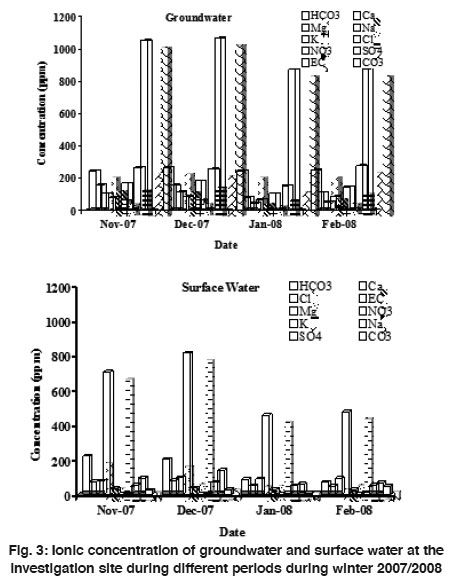 |
Figure 3: Ionic concentration of groundwater and surface water at the investigation site during different periods during winter 2007/2008 Click here to view figure |
Laboratory Works
The chemical analyses of the collected water samples were conducted at the laboratories of the Ministry of Water and Irrigation. The analyses comprises the following parameters: Ca2+, Na1+, K1+, Mg2+, HCO31-, Cl1-, SO42--, NO31-. Major ions (Cl-, NO-3, SO4-, Na+, K, Mg++ and Ca++) were analyzed using ion Chromatograph, equipped with analytical column CS12 (4×250 mm) CG12 (4×50 mm) guard column and CSRS-II (4 mm) self regenerating suppressor for cations and IonPac® AS4A-SC
(4x250 mm) analytical column, AG4A-SC (4x50 mm) guard column and ASRS-I (4 mm) self regenerating suppressor for ions (Dionex, USA), whereas HCO3 were analyzed using titration method. Furthermore, the deuterium and 18O isotopic concentration were measured for all the collected samples. The hydrological and hydrogeological data were interpreted.
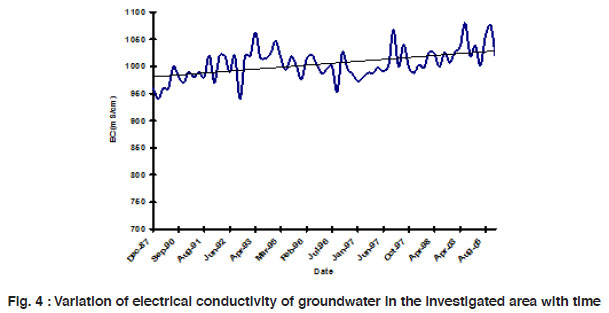 |
Figure 4 : Variation of electrical conductivity of groundwater in the investigated area with time Click here to view figure |
Results and Discussion
Four measuring sites of 350 m long were selected up and down of the diversion weir to estimate the recharge rates. Results showed that the recharge rate ranged from 0.05 to 0.21m3/m (Fig. 2), which was in agreement with the measurements of static water level recorded in the monitoring wells downstream as the water level raised about 5 cm within three months at well No.11 which is located very close to the diversion weir.
The wet pluvial season during winter 2007/ 2008 was below average as the precipitation fall during the investigated period was around 50% of its annual average for this time of the year. Therefore, the water quality of this season will be higher salinity than its normal situation. The water quality of the investigated area is affected by the amount of discharge from different sources which are springs base flow from Tafileh area, effluent from Tafileh treated wastewater treatment plant during summer season in addition to a new source of low salinity water originates from floods along Tafileh region during winter seasons.
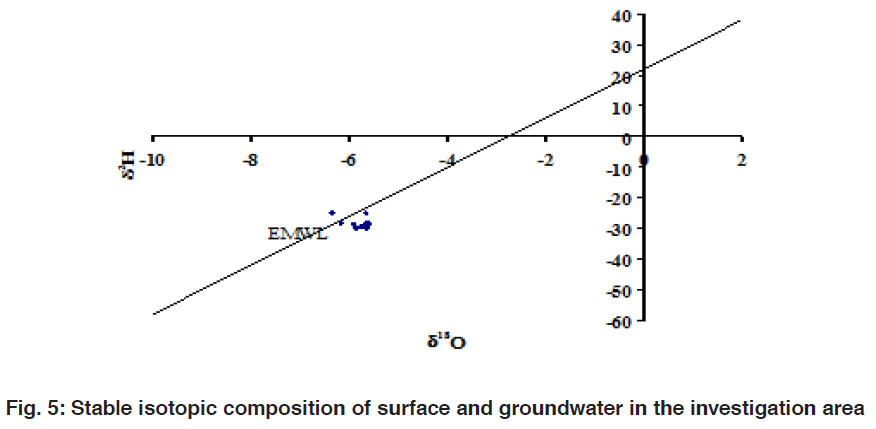 |
Figure 5: Stable isotopic composition of surface and groundwater in the investigation area Click here to view figure |
The major ionic concentration of the water in the investigated site at different periods during winter 2007/2008 is shown in figure 3. Results indicated that there is an increase in TDS during the first two months of the investigated period due to no rain during November and December 2007, whereas, during January and February 2008 a decrease in all ionic concentrations in both surface and groundwater was observed. This dilution effect of the surface runoff and groundwater during the later two months is due to recharge during rainfall periods as mentioned above where the fresh water component originated from rainfall of low ionic content (Jaradat et al., 1998) on the mountainous region of Tafileh area reached the area. The effect of dilution is supported by the amount of recharge as shown in figure 2, where with increasing recharge a decrease of groundwater salinity was observed. The ionic composition of both surface and groundwater reflects the lithology of the area as they contain high concentrations of HCO-3 and Ca++ and Mg due to the dissolution effect of carbonates.
By comparing the water salinity of surface water with groundwater during different periods it was found that surface water was of lower salinity than groundwater which can be due to longer contact period between rocks and water in the aquifers.
The high pH of the water at the beginning of the experiment ranged from 8.6 to 8.7, high pH raised the formation of CO-3 which is found at pH above 8.3 (Fresenius et al., 1987). The most probable source of water is from the effluents produced from Tafileh wastewater treatment plant. The high pH in both surface and groundwater decreased to 7.6-7.7 with occurrence of winter flood as the floods originated from rainfall had almost neutral acidity due to the buffering effect of CaCO3.
The effect of water recharge on groundwater quality for a long period (1987-2005) is shown graphically in fig. 4. It is clear that there was fluctuation in Electrical conductivity (EC) every year where it was low at the end of winter seasons rising to its maximum value at the end of summer season. Generally, there is a slight increase in salinity with time which is much lower than expected under high abstraction amounts that it is attributed to the recharge of Feifa stream into the groundwater of the area.
Stable isotopic composition of water collected from surface and groundwater are shown graphically in Figure 5. The results showed that both sources of water are plotted near the MMWL indicating same origin of water which is rain water without strong evaporation effect.
The tritium concentration of both surface and groundwater were less than 1 indicating that the most probable source of water in the investigation area is from old groundwater in form of base flow in addition to treated wastewater source. This can be due low amount of rainfall which had no significant impact on groundwater quality as well as the ratio of rainwater to base flow and effluent from wastewater effluent was too low.
Conclusions and Recommendation
Results of this investigation showed the followings:
-
The selected site was suitable for artificial recharge purposes.
-
Constructed diversion weir at Wadi Feifa improved both quality and quantities of the groundwater in the area.
-
Rate of recharge ranged from 0.05 to 0.21m3/ m.
-
Artificial recharge raised the water table of the investigated area by around 5 cm within three months period.
It is highly recommended to establish similar sites along the Jordan valley to improve both quality and quantity of its resources.
Acknowledgements
Sincere thanks for UNESCO for their financial support of this investigation. We are very thankful to his Excellency Eng. Khaldoon Kheshman for his support to the project team during this investigation.
References
- El-Naser, H., Groundwater resources of the deep aquifer system in NW Jordan - Hydrogeological and hydrochemical quasi 3-dimensional modeling, Hydrogeology and Umwelt, H.3, Wùrzburg, Germany (1991).
- Fresenius, W., Quentin, K and Schneider, W., Water Analysis, Springer verlag, Berlin (1987).
- Haddadin, M., Water resources in Jordan, RFF press book, Washington, USA (2006).
- Jaradat, Q. Momani, K., Jiries, A., Batarseh, M., Sabri, T., and Momani, I., Chemical composition of Urban wet deposition in Amman, Jordan. Water ,Air & soil poll., (1998) 112: 55-65.
- Ministry of Environment, National Capacity Self Assessment for Global Environmental Management (NCSA)- Jordan (2006).
- NWMP, National Water Master Plan of Jordan, 8 vol. Hannover, Bundesanstalt für Geowissenschaften und Rohstoffe, GTZ, Eschborn (1977).
- Parker, D. H., Investigation of the sandstone aquifers of East Jordan. UNDP, AGL: SF/Jor. 9., Rome 1970 (1970).






